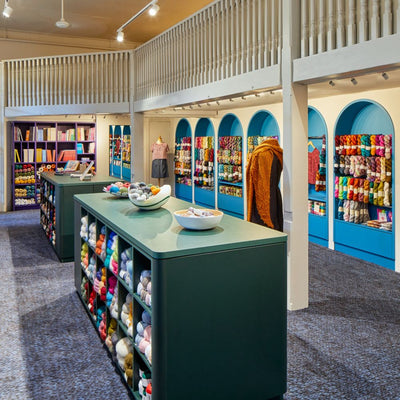Slipping stitches
July 07 2015 – thisisknit
"Slip a stitch" is a frequent instruction in patterns. It comes up in decreases, in some sorts of colourwork, at selvedges - all over the place, in fact. But it's not always clear whether to slip knitwise or purlwise, and it can really make a difference.
So here's the reason. When a stitch is sitting on your needle, it's always at a bit of an angle. For the way most of us knit, the right hand side of the stitch is a bit closer to the tip of the needle than the left side.
 But look what happens if you slip the stitch as if you were going to knit it. The needle goes into the stitch from left to right, and it starts to turn to face the knitter.
But look what happens if you slip the stitch as if you were going to knit it. The needle goes into the stitch from left to right, and it starts to turn to face the knitter.
 Continue to slip the stitch like this so that it moves off the left needle entirely and onto the right, and this is what you get. The stitch has turned round so that it's facing the other way to all the rest.
Continue to slip the stitch like this so that it moves off the left needle entirely and onto the right, and this is what you get. The stitch has turned round so that it's facing the other way to all the rest.
 This is the result that you want in an SSK decrease, for example. The stitch is turned round so that it's not going to be twisted after the decrease is worked. There's more about this at our directional decreases blog post.
So what happens if you slip purlwise? Well, let's see:
This is the result that you want in an SSK decrease, for example. The stitch is turned round so that it's not going to be twisted after the decrease is worked. There's more about this at our directional decreases blog post.
So what happens if you slip purlwise? Well, let's see:
 The needle goes into the stitch from right to left, exactly as it does when you purl, and then when the stitch has shifted from the left needle to the right, you'll see this:
The needle goes into the stitch from right to left, exactly as it does when you purl, and then when the stitch has shifted from the left needle to the right, you'll see this:
 The stitch is oriented the same way as the other stitches, with no change at all.
So when do you slip knitwise and when purlwise? There's a handy rule of thumb: if the stitch is going to be involved in a decrease right away this moment, then slip knitwise. But the rest of the time, slip purlwise so it's the same as all its companions, apart from not being worked. (Unless the pattern tells you otherwise, of course!)
There's some more to say about stitch orientation and how it happens, so stay tuned!
The stitch is oriented the same way as the other stitches, with no change at all.
So when do you slip knitwise and when purlwise? There's a handy rule of thumb: if the stitch is going to be involved in a decrease right away this moment, then slip knitwise. But the rest of the time, slip purlwise so it's the same as all its companions, apart from not being worked. (Unless the pattern tells you otherwise, of course!)
There's some more to say about stitch orientation and how it happens, so stay tuned!
 But look what happens if you slip the stitch as if you were going to knit it. The needle goes into the stitch from left to right, and it starts to turn to face the knitter.
But look what happens if you slip the stitch as if you were going to knit it. The needle goes into the stitch from left to right, and it starts to turn to face the knitter.
 Continue to slip the stitch like this so that it moves off the left needle entirely and onto the right, and this is what you get. The stitch has turned round so that it's facing the other way to all the rest.
Continue to slip the stitch like this so that it moves off the left needle entirely and onto the right, and this is what you get. The stitch has turned round so that it's facing the other way to all the rest.
 This is the result that you want in an SSK decrease, for example. The stitch is turned round so that it's not going to be twisted after the decrease is worked. There's more about this at our directional decreases blog post.
So what happens if you slip purlwise? Well, let's see:
This is the result that you want in an SSK decrease, for example. The stitch is turned round so that it's not going to be twisted after the decrease is worked. There's more about this at our directional decreases blog post.
So what happens if you slip purlwise? Well, let's see:
 The needle goes into the stitch from right to left, exactly as it does when you purl, and then when the stitch has shifted from the left needle to the right, you'll see this:
The needle goes into the stitch from right to left, exactly as it does when you purl, and then when the stitch has shifted from the left needle to the right, you'll see this:
 The stitch is oriented the same way as the other stitches, with no change at all.
So when do you slip knitwise and when purlwise? There's a handy rule of thumb: if the stitch is going to be involved in a decrease right away this moment, then slip knitwise. But the rest of the time, slip purlwise so it's the same as all its companions, apart from not being worked. (Unless the pattern tells you otherwise, of course!)
There's some more to say about stitch orientation and how it happens, so stay tuned!
The stitch is oriented the same way as the other stitches, with no change at all.
So when do you slip knitwise and when purlwise? There's a handy rule of thumb: if the stitch is going to be involved in a decrease right away this moment, then slip knitwise. But the rest of the time, slip purlwise so it's the same as all its companions, apart from not being worked. (Unless the pattern tells you otherwise, of course!)
There's some more to say about stitch orientation and how it happens, so stay tuned!


0 comments